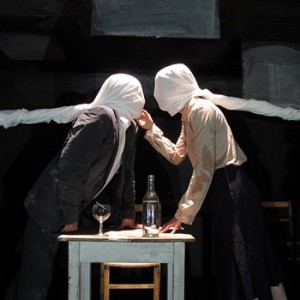
Last week, I went to Curious Directive’s show Your Last Breath. Curious Directive create devised theatre works incorporating scientific ideas, and this piece tells the story of an extreme skiing accident that led to the discovery of suspended animation, a story interwoven with three others, taking place at different times over 150 years, and told through spoken word, movement, music and video.
I thought the piece was very strong and it made me think about science in theatre, and Arts Catalyst’s involvement in theatre and performance over the years. Setting up Arts Catalyst 18 years ago, I wanted to explore and develop new types of engagement between artists and scientists to see if it was possible to create more symbiotic relationships between the two fields. I was also interested in seeking out artists whose work might express both the form and content of an interdisciplinary engagement. Some of our early work (around 1994-96) included theatre workshops and commissions. I didn’t consciously move away from theatre, but the playwright Diane Samuels, who attended our 1997 Eye of the Storm art and science conference at the Royal Institution, noted that the speakers were mainly visual artists (as well as scientists), and not theatre practitioners, and it led her to wonder: “Is there a playwright who has truly collaborated with a scientist rather than used scientific material to feed their work? Is such a thing possible?”
It was a question that Samuels went on to explore in her playwriting, while the Arts Catalyst has continued to work with artists across a broad spectrum of visual arts and contemporary performance practices. We have worked with artists who would describe themselves as live artists, sound artists, musicians, video artists, media artists, choreographers, dancers, bioartists, sculptors, writers, painters, conceptual designers, and others, so we tend just to use the terms “contemporary art” and “artists”.
Our curatorial vision has been to enable experimental and critical artistic engagements with contemporary science. Over the years, we have experimented with many forms of engagement, including multidisciplinary labs and field trips, research clusters, etc. While much of our commissioned work is shown in galleries, we tend towards a process-based, performative approach, and we often present work in experiential or event-based forms. We’ve commissioned works from several live artists, including Laurie Anderson, Marcel.li Antunez Roca, Aaron Williamson, Anne Bean, Ansuman Biswas, and Kira O’Reilly, as well as Critical Art Ensemble’s “participatory theatre”, which I wrote about in an essay ‘Performative Science: The case of Critical Art Ensemble’ for ‘Interfaces of Performance’, a publication exploring contemporary performance incorporating state-of-the-art technologies. So I’d say our curatorial door is certainly open to theatre practitioners, and we have included several writers, performance artists and theatre makers in our various workshops and field trips. But we’ve not been involved in the scripted form of theatre for many years.

Of course, there have been great plays that interweave themes of science in their stories – Bertolt Brecht’s marvellous The Life of Galileo (1937), Friedrich Dürrenmatt’s The Physicists (1961), and George Bernard Shaw’s The Doctor’s Dilemma (1906), which – unsurprisingly, given its contemporary relevance – is about to have a re-staging at the National Theatre. There have also been successful mainstream plays that experimented with weaving science into the dramatic form of the play, such as Michael Frayn’s skillful Copenhagen (1998), and Tom Stoppard’s Hapgood (1988).
Lately, just as there is an explosion of visual artists engaging with science, there seems to be a huge increase in theatre shows that incorporate scientific ideas. Of course, no one goes to the theatre or to an art gallery to find out about science. At least, I don’t think so – there are surely better ways to find out about science. They go for an experience that will be social, transformative, uplifting, challenging, entertaining. So the issue is always: is the work good? Does it uplift, unsettle, move, provoke or fascinate?
After being unmoved by a succession of plays engaging with scientific ideas, in 2010 the US theatre critic Alexis Soloski asked: “Why does theatre plus science equal poor plays?” In the UK last year, critics were generally unimpressed by the National Theatre’s multi-authored climate change play Greenland, Paul Callan in the Express calling it “two solid … hours of hectoring and statistics”. Were these indicators of the danger of becoming so enthralled by the science that the playwright/artist neglects the art? Or were they just unsuccessful plays that happened to have science in them? Any play can fail.
Increasingly, I’ve become aware (certainly in the UK) that there is some exciting stuff around by contemporary theatre makers, who are intrigued by science and its cultural and societal implications, and incorporating it into their work; many of whom are also experimental in their processes and form. Curious Directive, Third Angel, Unlimited, and Reckless Sleepers have been brought to my attention. The arts journalist Honour Bayes wrote in the Guardian last year that (far from “poor”) the results of the engagement between theatre and science were “exciting, explosive and unexpected”.
I’m deeply interested in the construction of stories, myths and metaphors and how these influence, and are influenced by, the direction of science and technology in a society. Clearly, theatre has an important role in this.

One comment